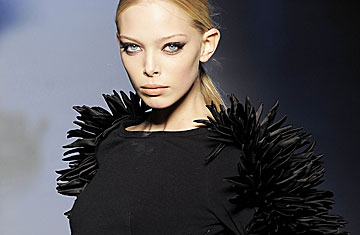
Dramatic Accents
Bold appliqués on the sleeves give volume and texture to an otherwise simple Etro column.
What is the value of perpetuating a brand if nobody in the design studio is paying any attention to the "codes," or DNA, of that brand? That was a question that loomed over the fall 2008 collections in Milan this week as brands as diverse as Gianfranco Ferre and Ferragamo tested the ability of newly hired designers or design teams to reinterpret the vision and vocabulary of an iconic name. At Ferre, the Swedish designer Lars Nilsson had been hired last September to much fanfare to channel the precision cuts and architectural shapes of the late Gianfranco Ferre, who passed away last June. But things didn't work out as planned and Nilsson was let go just two weeks before the show. A design team stepped in and did their best to rig up some voluminous white shirts and pencil-skinny pants, a familiar Ferre silhouette. The show lacked the kind of grand gestures and amazing technique for which Ferre was famous. At Ferragamo, the designer Cristina Ortiz showed a series of white coats and pantsuits and complicated draped dresses. It's hard to know what they had in common with the classic chic that Wanda Ferragamo still refers to when she talks about her husband's legacy.
Of course it takes time for these new translators to get the inflections and gestures right. But more often than not, I feel like I'm watching designers like Nilsson and Ortiz speak their own language under a different — and more well-known name — instead of trying to master the language of the house and then add their modern voice. Gucci designer Frida Giannini doesn't get much credit for her close study of the Gucci codes. For fall she demonstrated her fluency beautifully. It's taken about four seasons for Giannini to simultaneously speak her own language (bohemian, rock 'n' roll) in addition to Gucci's (rich materials, sexy silhouettes, and, let's face it, a certain amount of pile-it-on tackiness). Come fall, those studded boots, sash belts, tapestry bags and embroidered fur jackets will have Gucci's cash registers singing. Another successful example of a designer who has mastered the language of a famous brand is Donatella Versace. It took her a while to find her way, but Versace's fall show had an even balance of sexy, liquid silhouettes that are the house's signature and the structured day clothes Donatella has pushed in recent seasons.
The trends of the season — longer lengths, sharper tailoring, textures, and deep, inky colors — were well played out at places like Dolce & Gabbana, MaxMara and Burberry. But it was Miuccia Prada who, as usual, advanced the fashion agenda with her rigid and subversively sexual show featuring cotton and silk guipure lace layered over starchy cotton shirts and collars. Models marched toward the audience at an odd angle, on a raised platform that sloped down and twisted around the loft-like space. The Prada code is simple: it's always a contradiction, which this season means to be somehow transparent and also completely covered up.'